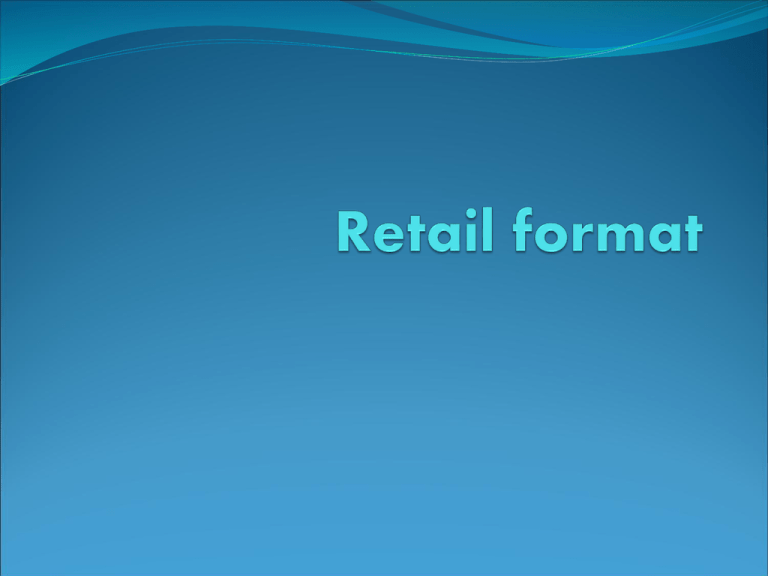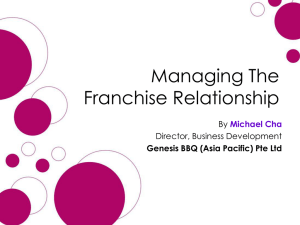Retail Format PPT 2
advertisement

Independent Also known as Kirana Store & Mom & Pop Store Retailers owns one retail unit Are run by owners & their families India has the highest no. of independent stores- kirana stores There are 9 million independent stores in India accounting to 70% of retail outlet Average size in India is app 25-30 sq. meter brands are limited Allow customer to buy on credit home delivery in neighborhood Employ members of extended family Takes order by Telephone Ease of entry into the market so many independent outlet . Advantages 1. 2. 3. 4. 5. 6. 7. Flexibility in choosing retail formats and locations Because only one location is involved , detailed specification can be chocked out Small segment of customers are catered to Investment cost for lease , fixture & workers can be held down prices, hours & other factors are set according to the segment Personal relation is created Free from unions & seniority rules Disadvantages In bargaining with suppliers, independent don’t have much power as they often buy in small quantities. Reordering maybe difficult if minimum order requirement is not full filled. Therefore Independents often form groups Loose on Economies of Scale High cost of transportation ,ordering & handling cost Labor intensive –everything is done manually less promotional strategy Overdependence on owners Little time for long run planning Chain Stores Multiple outlets, under a common ownership , so the decision making & purchasing is usually centralized Advantages a. Have bargaining power due to the purchase volume b. Can take advantages of media c. Use technology d. They usually give time to long run planning & may assign the job to someone for day to day management. e. Warehousing maybe centralized f. Less dependent on the owner & usually has trained management Disadvantages Difficult to find new locations Difficult to maintain consistency in terms of prices ,products, assortments firstly due to difference in management & secondly due to difference in local market Investment is higher. Managerial control is difficult Franchising A contractual agreement between a franchisor (a manufacturer, whole seller, service provider) & a retail franchise, which allows the franchise to conduct business under a established name & according to a given pattern of business The franchisee pays a initial fee & a monthly percentage of gross sales in exchange of exclusive rates to sell goods & service in that area. Trademark Franchising Acquires the identity of a franchisor by agreeing to sell the latters products & operate under the latters name. The franchise operates rather autonomously. There are certain operating rules but the franchisee set the store hours ,chooses a location & determines facilities and displays. Business Format Franchising Receive assistance on site location ,quality, control ,accounting system, startup practices, management training & responding to problems besides the right to sell goods & services. Prototype stores ,standardized product lines, cooperative advertising ,foster a level of coordination previously found only a chain stores. Types of Franchise Unit Franchising – Can operate only one unit Master- Grants large territories & sub franchising is allowed - Raymond's ,Titan, Wills lifestyle Development Agreement- Has right to operate multiple units in a territory but no sub franchising If they operate one outlet ,they are independent & 2 or more they are chains Advantages to Franchisee a. Acquire well known name b. Relatively small capital investment c. Standard operating procedure d. Cooperative marketing efforts e. Exclusive selling rates. f. Purchases may be less costly Disadvantages to Franchisee a. Oversaturation if too many in one area b. Locked into contracts requiring to purchase from one franchisor c. Cancellation clause d. Royalty Franchisor a. National global presence developed more quickly b. Franchisee have to abide by strict rules c. As franchisee owner so they work hard Disadvantages a. Harm the overall reputation if they do not adhere to co. standards b. Lack of uniformity among outlets adversely affects customer loyalty c. Intra franchise competition not desirable d. The resale value of individual unit is injured if franchisee performs poor Leased departments Is a department store inside a retail store. The leased department proprietor is responsible all aspects of its business. The retail store puts some operating restrictions to ensure overall consistency and coordination. Advantages for retailer Market is enlarged Personnel management, merchandize display and reordering all are undertaken by lessee. Regular store personnel do not have to be involved. Some expenses are paid by the LD so total cost of store is reduced. A % of revenue is received regularly. disadvantages Lessee may adversely affect the stores image. Advantage to the leased department Stores are known and have a steady walk in of customers. Costs are reduced Their image is enhanced by their relationship with popular store. Problems- the restrictions by the retailer in terms of hours and days of working and total products that can be stored are less Department store Large retail units with an extensive assortment of goods and services that are organized into separate departments for the purpose of selling. Wide range of products like apparel, furniture, appliances, home furnishing, toys, footwear, handbags , wallets, watches, jewelry and so on. with no one merchandize line predominating No grocery Convenience store Typically a well located food oriented retailer and carries a moderate number of items.(serving the catchment) Ranging from 1,500 to 5,000 sq. ft. in size All necessary everyday household items including milk, eggs, bread Limited number of brands Store area is small with an average atmosphere. with very less walking space.(aisle) Customer shop multiple types and the average transaction size.(average ticket size) Due to limited shelf space stores receive frequent deliveries. Simple and frequently used fruits and vegetable only. No elaborate layout. have the same entry exit door Easy day, twenty four seven, reliance fresh,6ten, Spencer's daily, food mart supermarket Big grocery store Large area- 10,000-30,00 square feet Large isles Non vegetarian section Variety of products with a large number of brands All household items including crockery, plastic goods, utensils Food bazaar ( by big bazaar),Spencer's super hypermarket Combination of department store and supermarket. Average size 60,000- 1,20,000 square feet Have on an average of 70,000 items Big bazaar, Spencer’S hyper Specialty Stores These include Lois Vuitton, the Body Shop, and Victoria’s Secret. These stores concentrate on one type of merchandise and offer it in a manner that makes it special. Some are very high-end (Louis Vuitton) while others cater to the price-conscious masses (Old Navy). The retail chains, which deal in specific categories and provide deep assortment within the category in them are specialty stores. Category Killer As the name suggests, category killer is a large retail chain store that dominates its product category so completely that it eliminates a large chunk of competition. Also known as big box store, a category killer is a discount speciality store that offers an extensive selection of merchandise at prices so low that smaller stores cannot compete (read survive). Discount Stores These are the stores or factory outlets that provide discount on the MRP items. They focus on mass selling and reaching economies of scale or selling the stock left after the season is over.











